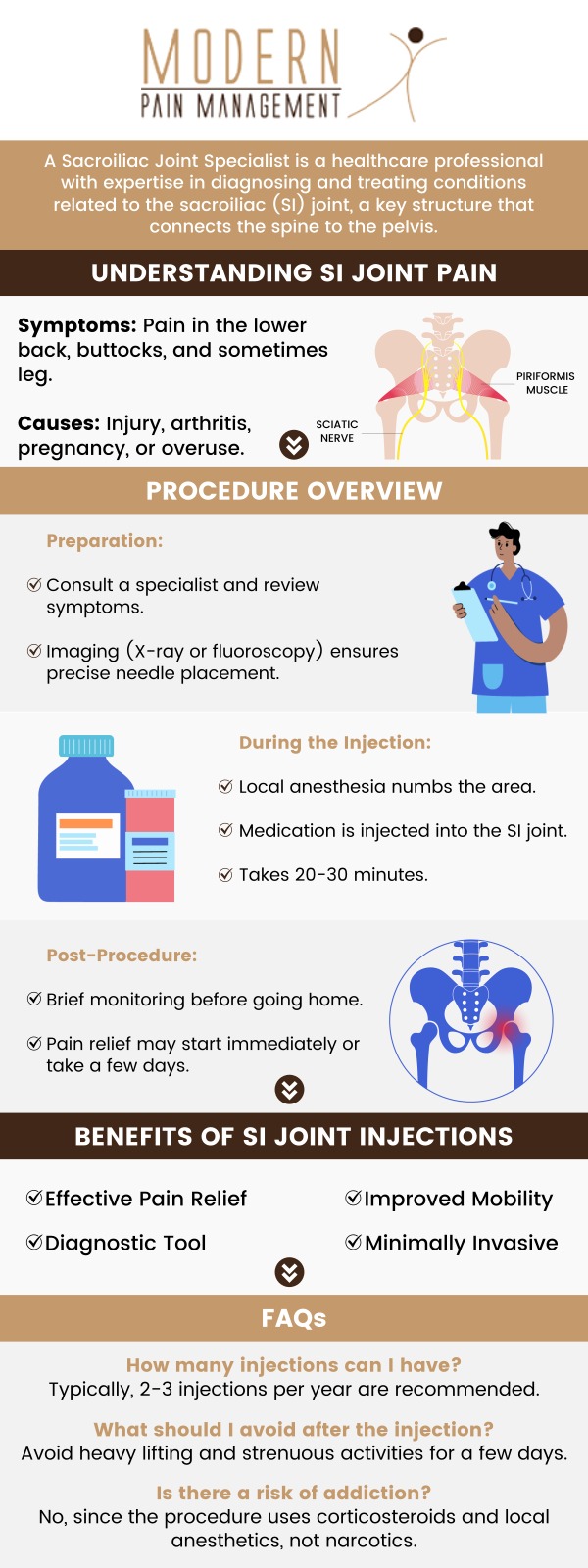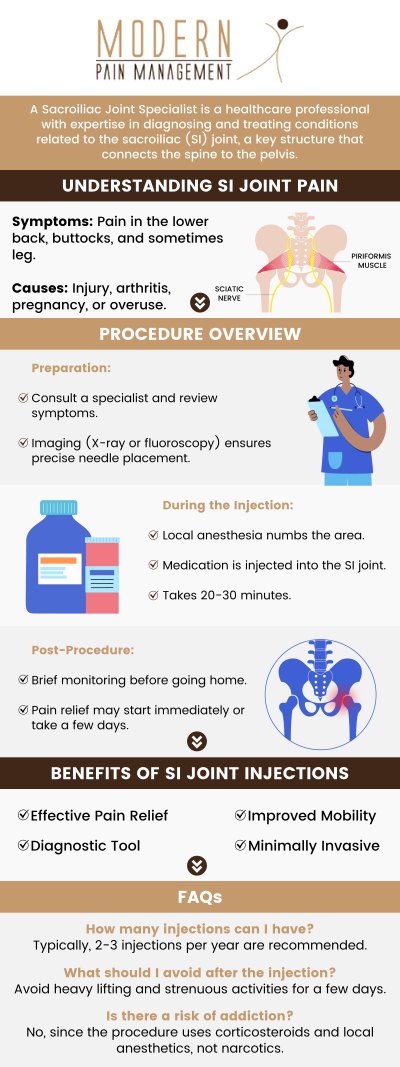Sacroiliac Joint Pain: Causes, Diagnosis, and When to Seek Care
Sacroiliac (SI) joint problems can occur as a result of osteoarthritis, injury, or other medical conditions. They can induce stinging or intense pain. SI joint pain can manifest as a sharp, stabbing pain that travels from your hips and pelvis up to your lower back and down to your thighs. Dr. George Atallah, D.O., and his team are trained in SI joint dysfunction and can assist you in diagnosing your condition. We have convenient locations to serve you in Houston TX and Sugar Land TX. For more information, contact us or request an appointment online.




Table of Contents:
What tests are needed to determine if my SI joint is causing my pain?
When is sacroiliac joint pain serious?
What triggers sacroiliac joint pain?
What is the difference between SI pain and sciatica?
Sacroiliac (SI) joint pain is one of the most common causes of lower back pain, but most people are not very familiar with this joint. It is located at the site where the spine and pelvis meet, functioning to provide shock absorption to the upper body. For those who experience SI joint dysfunction, they will likely experience varying levels of pain that take place in the lower back, fairly similar to sciatica.
There are a couple of different kinds of tests that will diagnose SI joint dysfunction to see if your SI joint is the cause of your pain, the most reliable of those tests is an injection test. The injection test consists of an injection of a numbing agent into the joint through the use of an x-ray or ultrasound to guide the medical practitioner that is administering the injection. If the pain goes away after the numbing agent is injected, it is clear that the joint is itself the problem. Another means to figure out if a patient is suffering from SI joint dysfunction is through a series of five physical maneuvering exams. If the patient tests “positive” for three out of five of the exams, SI joint dysfunction can be diagnosed. The five physical exams include FABER, compression, distraction, thigh thrust, and Gaenslen, all of which involve maneuvering the body into different positions and identifying it as positive if the pain is experienced in particular spots when put into those specific positions.
If the sacroiliac joint pain is acute, it will go away within several days to a few weeks. The pain can range from mild to severe, depending on how extensive the injury is, but can be felt all of the time and worsen when engaging in different activities. It is considered chronic once the pain persists for longer than three months. While there is no definitive timeline for seeing a doctor or specialist, if SI joint dysfunction is the likely problem, it will only worsen and be harder to treat the longer you wait to visit a physician. The key to treating chronic pain conditions is to address them as early as possible since it is unnecessary for anyone to have to continue experiencing pain such as that for very long before a trip to the doctor is wholly warranted.
There are many different causes of sacroiliac joint pain, including traumatic injuries to the site of pain and more specific underlying conditions. Some conditions that can lead to sacroiliac joint pain include arthritis, pregnancy, post-partum, systemic inflammatory conditions, infections, spinal scoliosis, leg length discrepancy, or a previous lumbar spine fusion. Unfortunately, much like many other chronic pain cases, it is also common for the cause of SI joint pain to remain unclear, making it more difficult to diagnose and treat.
Sacroiliac joint dysfunction and sciatica can be tricky to differentiate as they both result in lower back pain, typically affect one side of the body at a time, and can vary in pain intensity. However, the symptoms vary slightly, with SI joint pain often starting in the lower back, usually more on one side of the back as well, and being fairly easy to pinpoint. Sciatica is more difficult to diagnose because the pain begins in the lower back but continues down the sciatic nerve path. The symptoms of sciatica will likely cause the patient to experience numbness, sharp pain, and burning and tingling sensations all the way from the lower back, down the buttocks, and into the legs and feet. Symptoms associated with SI joint dysfunction will typically appear to be more in the pelvis, specifically with instability and reduced range of motion, as well as an increased pain level when putting more weight on one side than the other. SI joint pain will also more often entail a sharp, stabbing pain in the back of the thighs and the buttocks.
Modern Pain Management can help you treat your back or hip pain safely. We have convenient locations to serve you in Houston TX and Sugar Land TX. For more information, contact us or request an appointment online. We serve patients from Houston TX, Sugar Land TX, Pearland TX, Jersey Village TX, Missouri City TX, Stafford TX, and Richmond TX.
ADDITIONAL SERVICES YOU MAY NEED




